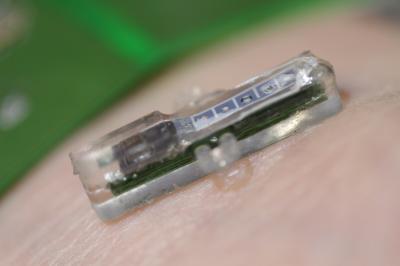Information is routed through a series of stages, from the patient's body to the doctor's computer screen. The implant emits radio waves over a safe frequency. The patch collects the data and transmits them via Bluetooth to a mobile phone, which then sends them to the doctor over the cellular network.
A system that can detect numerous substances
Great care was taken in developing the sensors. To capture the targeted substance in the body – such as lactate, glucose, or ATP – each sensor's surface is covered with an enzyme. "Potentially, we could detect just about anything," explains De Micheli. "But the enzymes have a limited lifespan, and we have to design them to last as long as possible." The enzymes currently being tested are good for about a month and a half; that's already long enough for many applications. "In addition, it's very easy to remove and replace the implant, since it's so small."
The electronics were a considerable challenge as well. "It was not easy to get a system like this to work on just a tenth of a watt," de Micheli explains. The researchers also struggled to design the minuscule electrical coil that receives the power from the patch.

EPFL scientists have developed a tiny, portable personal blood testing laboratory: a minuscule device implanted just under the skin provides an immediate analysis of substances in the body, and a radio module transmits the results to a doctor over the cellular phone network. This feat of miniaturization has many potential applications, including monitoring patients undergoing chemotherapy.
(Photo Credit: EPFL)
Towards personalized chemotherapy
The implant could be particularly useful in chemotherapy applications. Currently, oncologists use occasional blood tests to evaluate their patients' tolerance to a particular treatment dosage. In these conditions, it is very difficult to administer the optimal dose. De Micheli is convinced his system will be an important step towards better, more personalized medicine. "It will allow direct and continuous monitoring based on a patient's individual tolerance, and not on age and weight charts or weekly blood tests."
In patients with chronic illness, the implants could send alerts even before symptoms emerge, and anticipate the need for medication. "In a general sense, our system has enormous potential in cases where the evolution of a pathology needs to be monitored or the tolerance to a treatment tested."
The prototype has already been tested in the laboratory for five different substances, and proved as reliable as traditional analysis methods. The project brought together eletronics experts, computer scientists, doctors and biologists from EPFL, the Istituto di Ricerca di Bellinzona, EMPA and ETHZ. It is part of the Swiss Nano-Tera program, whose goal is to encourage interdisciplinary research in the environmental and medical fields. Researchers hope the system will be commercially available within 4 years.

This implant measures about 14mm and comprises five sensors, a coil for wireless power as well a miniaturized electronics for radio communication.
(Photo Credit: EPFL)

This implant measures about 14mm and comprises five sensors, a coil for wireless power as well a miniaturized electronics for radio communication.
(Photo Credit: EPFL)